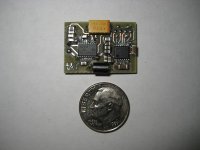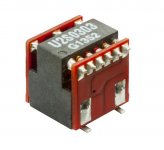Looking for dc-dc converters (preferably isolated) to power a small headphones amp and dac from USB, I realized that they were divided in two big categories: those switching under 100khz and those switching above 1Mhz.
Almost all the common SIP/DIP encapsulated modules from Murata or Delta are switching at about 60-100KHz. On the other hand, the TI DCP serie is switching at 800KHz-1.6MHz. A lot of the non-isolated controllers (requiring additionnal parts) are also switching at 1.6MHz.
So what's best for analog ? Both are in theory switching above the audio band. Efficiency is similar. The LF ones can be cleaned up with cap multipliers, the HF ones with simple LC pi-filters.
There's a lot more choice with the LF ones, is there a reason to avoid them and rather go for the HF ones ? Sorry if I missed something obvious.
Almost all the common SIP/DIP encapsulated modules from Murata or Delta are switching at about 60-100KHz. On the other hand, the TI DCP serie is switching at 800KHz-1.6MHz. A lot of the non-isolated controllers (requiring additionnal parts) are also switching at 1.6MHz.
So what's best for analog ? Both are in theory switching above the audio band. Efficiency is similar. The LF ones can be cleaned up with cap multipliers, the HF ones with simple LC pi-filters.
There's a lot more choice with the LF ones, is there a reason to avoid them and rather go for the HF ones ? Sorry if I missed something obvious.
The general reason to push the frequencies up is to shrink the device size. Whether this holds true here and whether there is a significant difference with only a factor of ~10 is another matter. Another general expectation is that the further from the application frequency, the easier to filter at that frequency. Of course these factors can be distorted by differences in the individual implementation, so knowing the above may not actually help much, and you may not care about the size.
I'd start with the cheapest. If it doesn't work out, then hopefully you get some pointers for your next choice.
I'd start with the cheapest. If it doesn't work out, then hopefully you get some pointers for your next choice.
I usually start from the transformer. What kind of transformer CAN I make?
For example, it is really difficult for me to make a good one turn primary transformer, so I dont make one.
I make 4 to 5 turns primary (and secondary) minimum.
And then check what frequencies I need to have to get the needed power (+ core size...)
For example, it is really difficult for me to make a good one turn primary transformer, so I dont make one.
I make 4 to 5 turns primary (and secondary) minimum.
And then check what frequencies I need to have to get the needed power (+ core size...)
counter culture : thanks  At the lower end of power requirements (1-2W), there's indeed a small size difference. The LF converters get as small as dip8 package, the isolated dcp can be found in so28 package and non isolated stuff like lm2611 are in sot23-5 but need an external inductor. In practice, it doesn't matter much to me. I was wondering though if radiated noise would be more of a problem at higher frequencies ?
At the lower end of power requirements (1-2W), there's indeed a small size difference. The LF converters get as small as dip8 package, the isolated dcp can be found in so28 package and non isolated stuff like lm2611 are in sot23-5 but need an external inductor. In practice, it doesn't matter much to me. I was wondering though if radiated noise would be more of a problem at higher frequencies ?
palstanturhin: just to clarify: the considered converters are very small ones (1-2W); they either are complete encapsulated solutions or controllers that just require a small of the shelf inductor.
palstanturhin: just to clarify: the considered converters are very small ones (1-2W); they either are complete encapsulated solutions or controllers that just require a small of the shelf inductor.
I made a little headphone amp with TPS60130 charge pump to be run off of a single lithium cell. I think the switching frequency was around 320kHz. Only filtering was the ceramic caps on the output and a ferrite bead; the thing was dead silent.
Yep, charge pump can be pretty awesome. Sadly, the selection available is very limited when it comes to higher voltages and their current delivery is quite limited.
This said, I think I found a pretty good compromise. The MTU2 serie from Murata has a 2W dual 12V converter which is a cute little cube (8.5*8.5*8.5mm).
Attachments
Higher switching frequencies can use smaller inductors and caps vs. lower switching frequencies. That's one of the advantage of higher switching freq. That said, 100K-150Khz is pretty okay even for audio use. The PSRR of the preamp/whatever will take care of the rest. The outputs of these ready-made DC/DC converters are pretty good when checked on a scope (not perfect flat line, but good enough). Check out the datasheet, as some of them recommend adding both an input and output capacitor for even cleaner DC outputs. Very easy to use, minimal parts count. Just add ceramic and electrolytic caps and you're up and running.
Now, if you'll be rolling out your own DC/DC converter, make sure to use "Shielded inductors" as they limit RF noise. SMD inductors seem to be better than through hole inductors. SMD inductors are also easier to find, vs. TH inductors (which are more expensive too).
Now, if you'll be rolling out your own DC/DC converter, make sure to use "Shielded inductors" as they limit RF noise. SMD inductors seem to be better than through hole inductors. SMD inductors are also easier to find, vs. TH inductors (which are more expensive too).
one very important thing to know is the type of dcdc converter. flyback converters (most small dcdc converter are flyback) are often of the variable frequency type so you can never plan for possible aliasing frequencies.
the best for audio is the fixed frequency LLC type, where the currents are of sinusoidial shape. you may need a post regulator to stabilize furthe,r or vary the frequency.
the best for audio is the fixed frequency LLC type, where the currents are of sinusoidial shape. you may need a post regulator to stabilize furthe,r or vary the frequency.
- Status
- This old topic is closed. If you want to reopen this topic, contact a moderator using the "Report Post" button.
- Home
- Amplifiers
- Power Supplies
- DC-DC converters for analog: high or low switching frequencies

